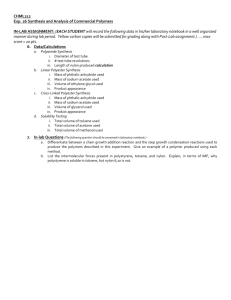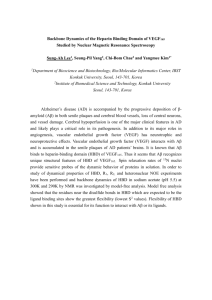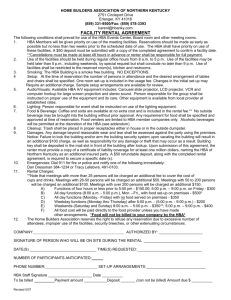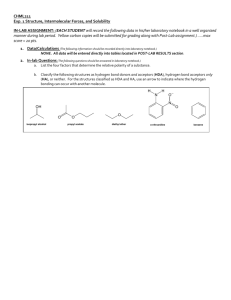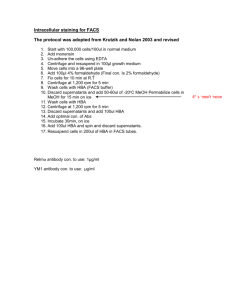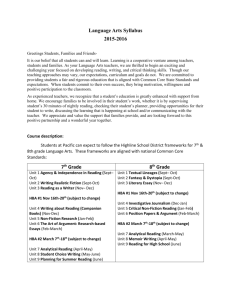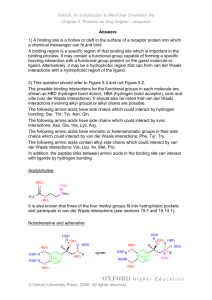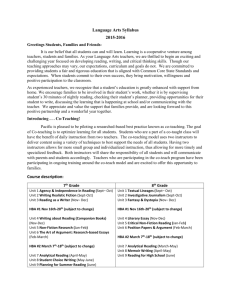PATRICK PROBLEMS 2 Key
advertisement
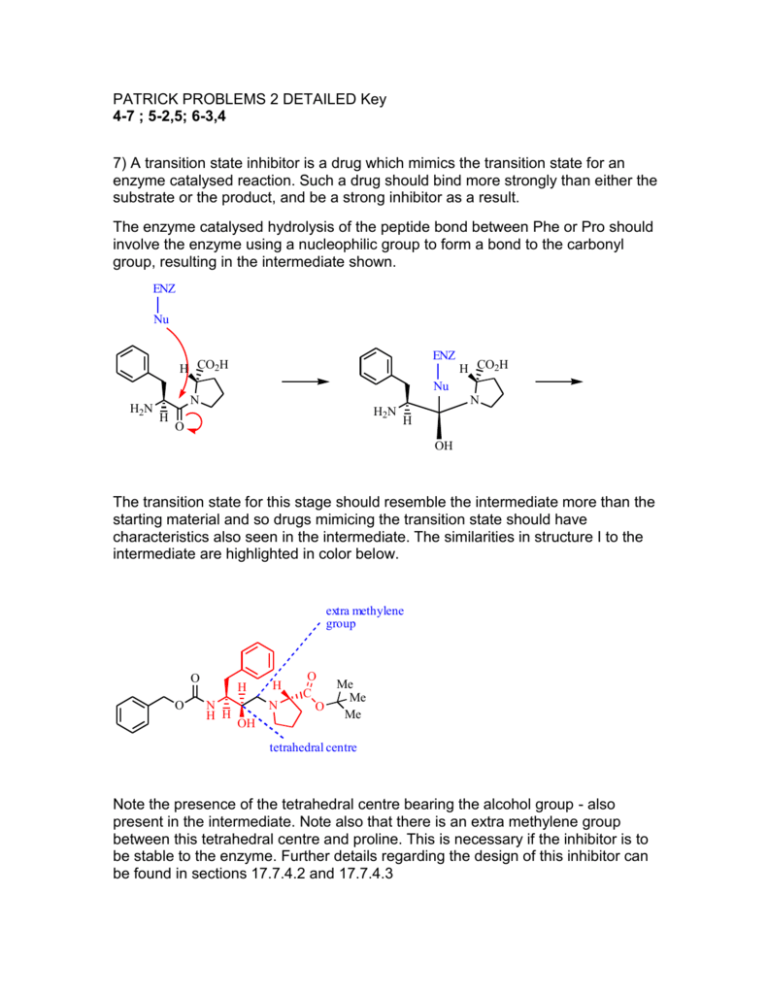
PATRICK PROBLEMS 2 DETAILED Key 4-7 ; 5-2,5; 6-3,4 7) A transition state inhibitor is a drug which mimics the transition state for an enzyme catalysed reaction. Such a drug should bind more strongly than either the substrate or the product, and be a strong inhibitor as a result. The enzyme catalysed hydrolysis of the peptide bond between Phe or Pro should involve the enzyme using a nucleophilic group to form a bond to the carbonyl group, resulting in the intermediate shown. ENZ Nu ENZ H CO2H H2N Nu N H H2N O H CO2H N H OH The transition state for this stage should resemble the intermediate more than the starting material and so drugs mimicing the transition state should have characteristics also seen in the intermediate. The similarities in structure I to the intermediate are highlighted in color below. extra methylene group O O H N H H H N OH O Me C Me O Me tetrahedral centre Note the presence of the tetrahedral centre bearing the alcohol group - also present in the intermediate. Note also that there is an extra methylene group between this tetrahedral centre and proline. This is necessary if the inhibitor is to be stable to the enzyme. Further details regarding the design of this inhibitor can be found in sections 17.7.4.2 and 17.7.4.3 An IC50 6500 nM means that the concentration of inhibitor required to inhibit the enzyme by 50% is 6500 nanomolar. 5-2) This question should refer to Figure 5.3 and not Figure 5.2. The possible binding interactions for the functional groups in each molecule are shown as HBD (hydrogen bond donor), HBA (hydrogen bond acceptor), ionic and vdw (van der Waals interactions). It should also be noted that van der Waals interactions involving alkyl groups or alkyl chains are possible. The following amino acids have side chains which could interact by hydrogen bonding: Ser, Thr, Tyr, Asn, Gln. The following amino acids have side chains which could interact by ionic interactions: Asp, Glu, His, Lys, Arg. The following amino acids have aromatic or heteroaromatic groups in their side chains which could interact by van der Waals interactions; Phe, Tyr, Try. The following amino acids contain alkyl side chains which could interact by van der Waals interactions; Val, Leu. Ile. Met, Pro. In addition, the peptide links between amino acids in the binding site can interact with ligands by hydrogen bonding. Acetylcholine HBA O H3C O HBA Ionic NMe3 It is also known that three of the four methyl groups fit into hydrophobic pockets and participate in van der Waals interactions (see sections 19.7 and 15.14.1). Noradrenaline and adrenaline HBD H HBD H HBA O O HBA HBD H HBA O H HBD H N R HBA vdw HBD H HBDH HBA O HBD H HBA HBD O H H H HBD N R vdw Ionic O HBA The amino group of both nordrenaline and adrenaline can exist as the free base or as the protonated, ionized form. Note that the nitrogen can act as a HBA in the free base but not when it is ionized. Further details on the binding interactions of noradrenaline and adrenaline can be found in sections 15.14.1, 20.8 and 20.9 Dopamine HBD H HBD H HBD H HBA O N HBD H HBA vdw HBD H HBD H O HBA HBD H HBA O N vdw O HBA H HBD H HBD Ionic The amino group of dopamine can exist as the free base or as the protonated, ionized form. Note that the nitrogen can act as a HBA in the free base but not when it is ionized. Further details on the binding interactions of dopamine can be found in section 15.14.1. Glycine Glycine is an amino acid which is more likely to exist as the zwitterion with both the amino and carboxylic acid groups being ionized. HBD H HBD H HBA O N C HBA HBD H O HBA HBD HBD H H N H Ionic HBD HBA O Ionic O HBA Serotonin HBD HBD H H HBD N H Ionic HBD HBD H N H HBA HBA O H HBD HBA O vdw N H HBD H HBD vdw N H HBD The amino group of serotonin can exist as the free base or as the protonated, ionized form. Note that the nitrogen can act as a HBA in the free base but not when it is ionized. Note also that the heterocyclic nitrogen is unlikely to be a good HBA since its lone pair interacts with the ring's system. Further details on the binding interactions of serotonin can be found in section 15.14.1. -Aminobutyric acid HBD H HBD H HBA O N HBD HBD H O HBA HBA HBA O HBD H H N H HBD Ionic Ionic O HBA Glutamic acid HBA O HBD H O HBA HBA O H HBA N H H HBD HBD Ionic HBD H HBA O O HBA O HBA HBA O H Ionic Ionic O HBA N H H HBD HBD H HBD 5-5) The inactive metabolite has a methyl ether rather than a phenol group. This indicates that the phenol group is an important binding group when isoprenaline interacts with the adrenergic receptor. For example, the hydrogen atom of the phenol group may act as a hydrogen bond donor to a corresponding hydrogen bond acceptor in the binding site. This interaction is no longer possible for the inactive metabolite. Another possibility is that the phenolic oxygen acts as a hydrogen bond acceptor and that the methyl group in the metabolite prevents this interaction due to its size and bulk (see also sections 11.2.6 and 20.10.3). HO H OHH N H CH3 CH3 HO Isoprenaline MeO OHH N HO CH3 CH3 Inactive metabolite 6-3) It is worth considering the interactions of estradiol and raloxifene with the estrogen receptor (Box 6.2) in order to answer this question. His 524 Me OH H H H N Side chain H Glu353 Asp351 H H His 524 O Glu353 O OH O Hydrophic skeleton H2O H O S Arg394 Oestradiol Arg394 Raloxifene Both estradiol and raloxifene contain functional groups that can interact through hydrogen bonding to the amino acids Glu353, Arg394 and His524. Both molecule have hydrophobic skeletons that position these groups correctly and match the hydrophobic nature of the binding site. Estradiol is an agonist whereas raloxifene is an antagonist. This is due to the extra interaction with Asp351 that is possible for raloxifene. Turning now to tamoxifen, this molecule is also hydrophobic and of a similar size to the above, allowing it to fit the hydrophoic binding site. It does not have the phenol or alcohol functional groups present in estradiol or raloxifene, but it does have a group that can interact with Asp351 in the same way as raloxifene, resulting in it acting as an antagonist. Asp351 H Me2N O Tamoxifen 4) Although tamoxifen itself is an antagonist, its metabolite is an agonist. This is because it has lost the group that is so crucial for antagonist activity (the side chain containing the amine). It also contains a phenol group which can mimic the phenolic group of estradiol (see above question 3). Asp351 Asp351 H Me2N HO O Glu353 Glu353 Tamoxifen Arg394 H Arg394 O Metabolite
